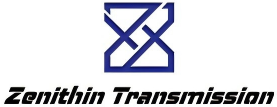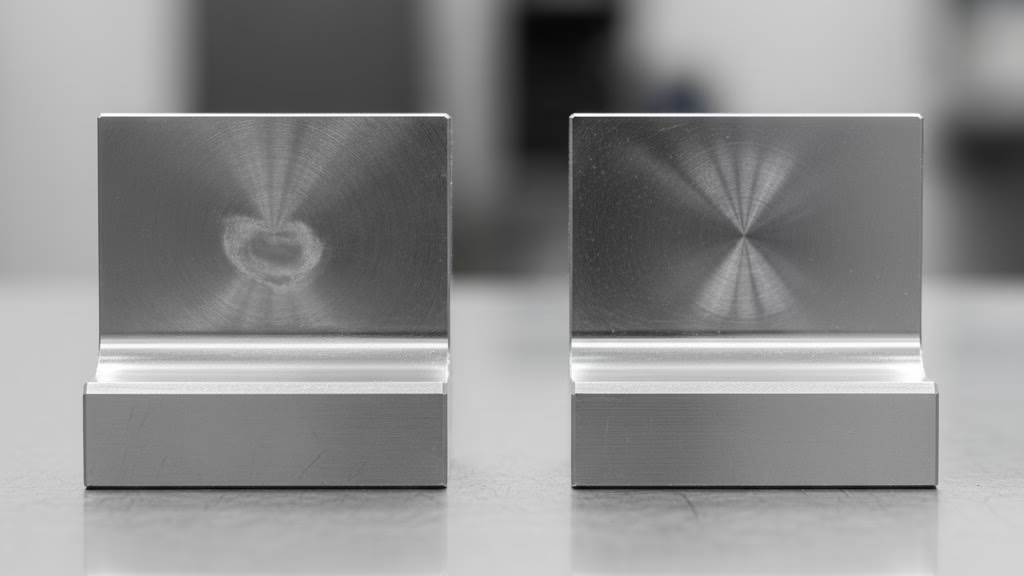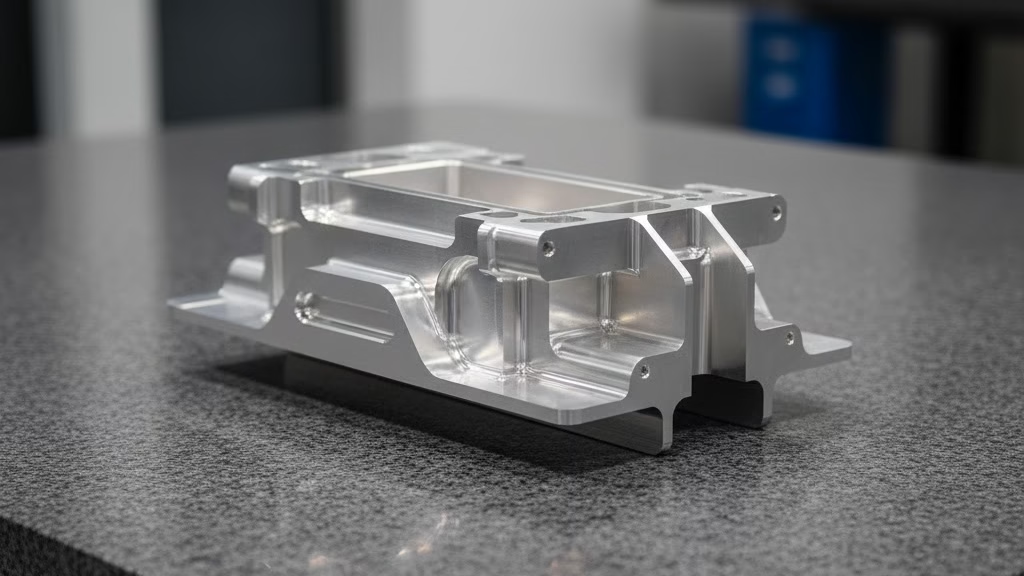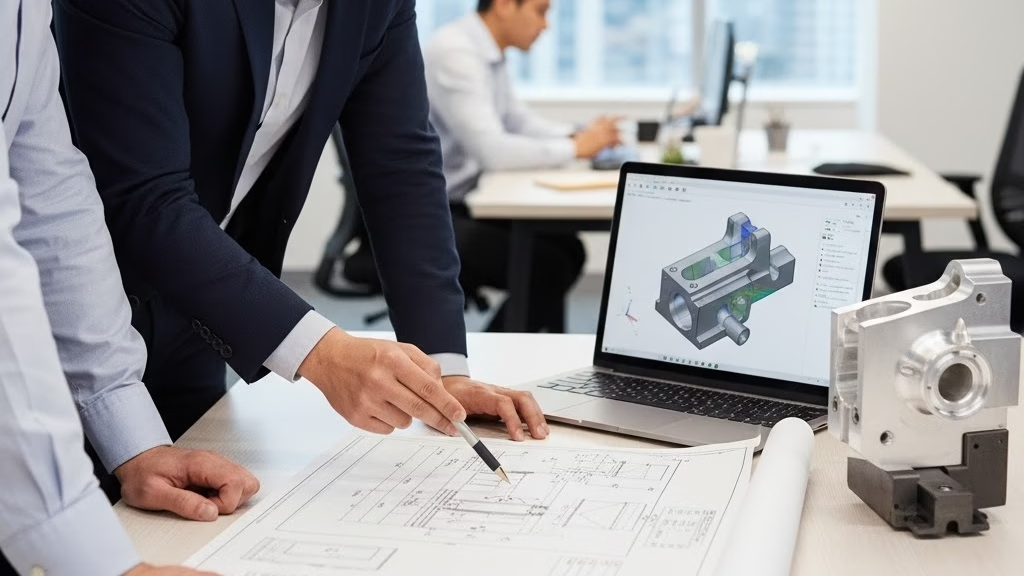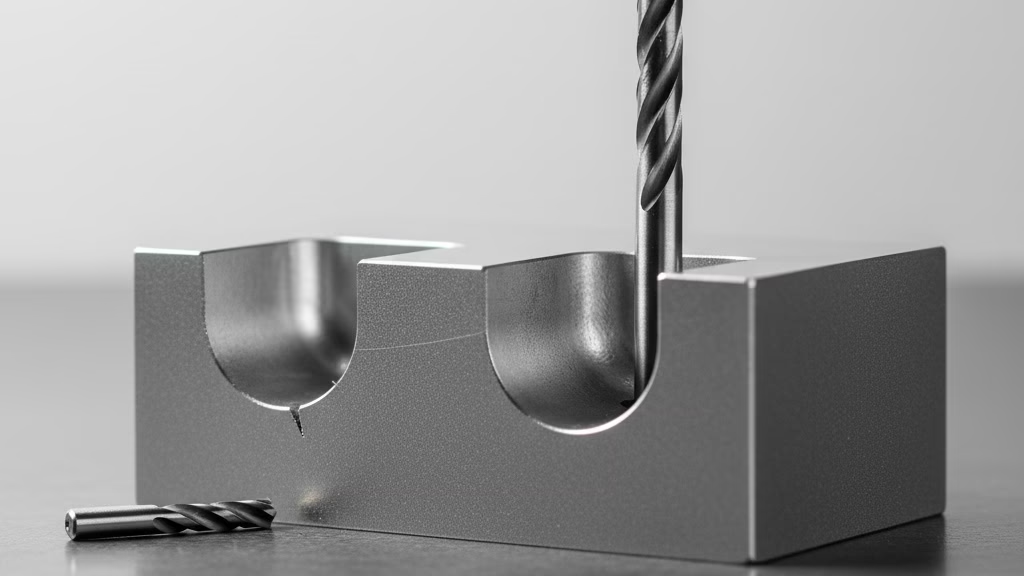If you’re an engineer shocked by a high CNC machining quote, you’re not alone. The problem often lies in one hidden metric: the Machinability Rating. This guide gives you the data and DFM strategies you need to master this number and take control of your final cost et machining time.
A Machinability Rating (MR) is a percentage that compares a material’s ease of being cut against a standard baseline (B1112 steel at 100%). A lower rating (e.g., 40% for 304 Stainless) indicates a material is harder to machine, which exponentially increases machining time, tool wear, and the final cost of your part.
But knowing the definition is just the start. In this guide, you’ll get real-world case studies and DFM strategies that show you how to utiliser this knowledge to make smart material selection choices that will save your project’s budget.
What Are Machinability Ratings?
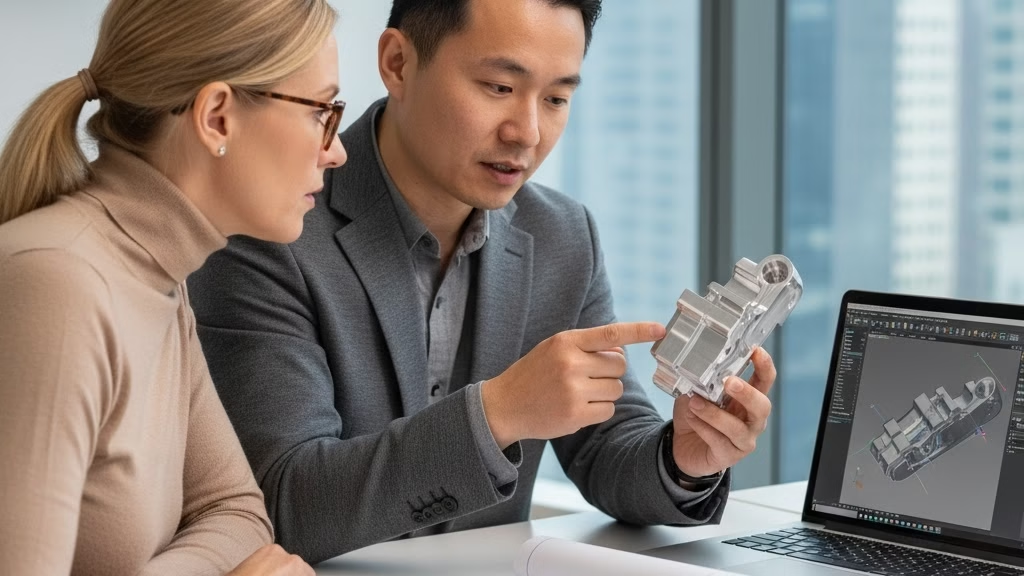
Forget the complex metallurgical textbooks for a moment.
In the simplest terms, a material’s Cote d'usinabilité (MR) is a number that tells you how “willing” it is to be cut. It’s a straightforward comparison that predicts how fast a material can be machined relative to a standard baseline.
That baseline is AISI B1112 (or 1212) steel, which is assigned a rating of 100%.
Here’s the critical part most people miss: B1112 isn’t an “average” material. It’s a free-machining steel specifically designed to be cut easily, with sulfur added to make its chips break off cleanly. This means 100% isn’t an average grade—it’s an ideal one.
Any material with a rating below 100% is more difficult, and often significantly more expensive, to machine.
The Engineer’s Machinability Cheat Sheet
This is the mental chart you should use for every design. It translates those abstract ratings into real-world difficulty.
| Material (Material) | Rating (MR) | Machining Difficulty (Our Take) |
|---|---|---|
| C360 Laiton | ~300% | Extremely Low (Like cutting butter) |
| Aluminium 6061-T6 | ~150% | Very Low (The “Go-To” for a reason) |
| B1112 Steel | 100% | (The Baseline) |
| 1018 Carbon Steel | ~70% | Medium (A bit “gummy”) |
| 4140 Alloy Steel | ~55-65% | Medium-High (Getting tough) |
| Acier inoxydable 304 | ~40% | High (Gummy & work-hardens) |
| Acier inoxydable 316 | ~35-40% | High (Even tougher than 304) |
| Ti-6Al-4V Titane | ~15-25% | Very High (The “Tool Killer”) |
| Inconel 718 | ~5-12% | Extreme (The “Nightmare” material) |
How MR Can Skyrocket Your Budget
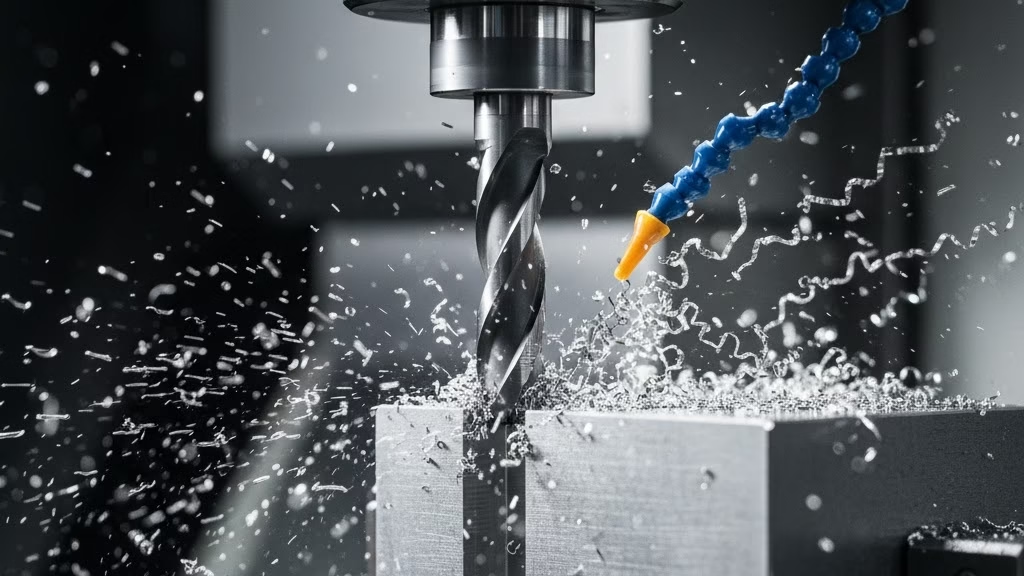
Here is the most common mistake engineers make: assuming the relationship is linear. They think, “This 40% MR material (304 Stainless) will take about twice as long to machine as that 80% MR material (1018 Steel).”
This assumption is wrong. And it’s an expensive mistake.
The hard truth is that the relationship between machinability and cost is exponential. A small drop in the rating often leads to a massive explosion in cost. Here’s why.
1. The Impact on Machining Time (MRR)
A material’s MR directly limits its Taux d'enlèvement de matière (MRR)—how fast you can physically cut it. A lower rating forces a machine shop to drastically reduce two key variables:
- Cutting Speed (Vc): How fast the tool spins.
- Feed Rate (f): How fast the tool moves across the part.
When you machine a difficult material like titanium, you can’t just slow down a little. You have to slow down a lot to prevent the tool from melting.
The result: A 50% drop in the MR (say, from 80% to 40%) doesn’t double the machining time. It can force a 300%, 400%, or even 500% augmenter in the total time spent on the machine.
2. The Impact on Tool Life
As if the added time wasn’t bad enough, difficult materials destroy cutting tools.
There’s a classic formula (Taylor’s Tool Life Equation) that proves this. In simple terms: for tough materials like stainless steel, trying to “save time” by increasing the cutting speed by just 20% can reduce your tool’s lifespan by 80%.
This means your supplier isn’t just billing you for the extra machining time. They are billing you for:
- More expensive, specialized cutting tools.
- The cost of the tools that were destroyed.
- The machine downtime to stop and change out all those broken tools.
A Real-World Cost Comparison
Let’s put this all together in a simple cost model. Assume a machine shop’s hour rate is $100.
Total Cost = Material Cost + Machine-Hour Cost + Tooling Cost
Part A: 6061-T6 Aluminum (MR = 150%)
- Coût des matériaux : $20
- Temps d'usinage : 15 minutes
- Machine-Hour Cost: $25 (0.25 hr @ $100/hr)
- Coût de l'outillage : $1 (Tools last forever in aluminum)
- TOTAL COST: $46
Part B: 316 Stainless Steel (MR = 40%)
- Coût des matériaux : $40 (Looks like it’s only $20 more, right?)
- Temps d'usinage : 90 minutes (Time increased 6x!)
- Machine-Hour Cost: $150 (1.5 hr @ $100/hr)
- Coût de l'outillage : $25 (Requires premium tools, wears fast)
- TOTAL COST: $215
The Final Tally: The stainless steel material was only $20 more expensive to buy. But the final part cost $169 more to produce.
This is how a low machinability rating punishes a budget. It doesn’t add cost; it multiplies it.
Facing a Difficult Material Choice?
Before you commit to a material that could skyrocket your budget, let our engineers review your design. We specialize in finding the perfect balance between material properties and manufacturing cost.
Design Strategies When You Have “No Choice”
Sometimes, you can’t just pick 6061 aluminum. Your design doit use titanium for its strength-to-weight ratio, or 316 stainless for its biocompatibility. What then?
The best engineers don’t just accept a 10x cost increase. They use Conception pour la fabrication (DFM) to fight back and control those costs.
As Dr. Scott Smith, a manufacturing expert at the University of North Carolina at Charlotte, notes, “Design for Manufacturability (DFM) must…treat ‘machinability’ as a primary design constraint, just like strength or hardness.”
Here are three DFM strategies you can use to lower the cost of machining difficult materials.
1. The High Cost of Tight Tolerances
Tolerances are a perfect example.
- Achieving a
±0.001"tolerance on 6061 aluminum is routine. - Achieving that même
±0.001"tolerance on 316 stainless is an expensive, high-risk operation that requires slow speeds, specialized tools, and multiple finishing passes.
Actionable Advice: Review your drawing. Does that non-critical surface vraiment need such a tight profile? By relaxing your non-critical tolerances, you give the machinist the ability to use more efficient (i.e., faster) cutting strategies, which can directly reduce your part cost.
2. The Curse of “Difficult Features”
A material’s machinability rating plummets when it’s forced to interact with difficult geometry.
- Sharp Internal Corners: These are tool killers. To create a “perfect” 90-degree internal corner, a shop has to use a tiny tool or a separate EDM process. On a tough material like stainless steel, this is where tools are most likely to break.
- Deep, Narrow Pockets: On titanium, deep pockets are a nightmare. The chips can’t get out, heat builds up instantly, and the tool melts.
Actionable Advice: Add a corner radius to all internal pockets. Simply changing a “sharp” corner to an R > 0.8mm (0.031″) radius allows the shop to use a standard, more robust end mill, dramatically increasing speed and reliability.
3. Hidden Killers Beyond the Rating Chart
Finally, the rating on the chart isn’t the full story. Three hidden factors can change everything:
- Work Hardening: Materials like 304 stainless are infamous for this. The very act of cutting them makes the surface harder. If a tool hesitates or rubs, it creates a hardened layer that the next pass can’t cut through.
- Thermal Conductivity: Titanium is expensive because it’s a terrible conductor of heat. When you cut aluminum, 80% of the heat leaves with the chip. When you cut titanium, 80% of the heat stays right at the tool’s tip, trying to melt it.
- Traitement thermique : The same material can have two different ratings. 4140 alloy steel in its soft “annealed” state is manageable (MR ≈ 65%). But 4140 in its “pre-hardened” state (MR ≈ 40%) is a different beast entirely. Always specify the material et its condition.
Real-World Cases: How Expert DFM Saves a Project
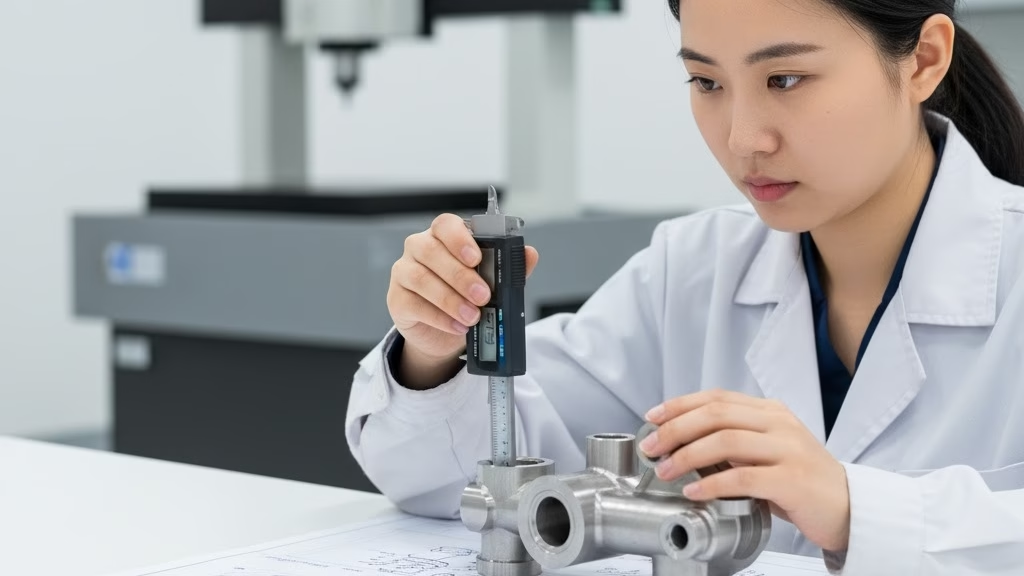
These are not just theories; we see these scenarios play out with our customers every week. Here are three quick examples of how a DFM-focused approach (built on understanding machinability) makes a real-world difference.
Case 1: The 304 Stainless Steel “Nightmare”
- Le problème : A medical device client sent us a design for a 304 stainless steel manifold. It had multiple deep, small-diameter holes (
Ø1.5mm) and required a very high-quality internal surface finish for fluid dynamics. - The Analysis: We knew the “gummy” and “work-hardening” nature of 304 steel would make this nearly impossible. Drilling those deep holes would cause the material to harden, risking drill breakage, and the “tearing” action of cutting 304 would leave a rough internal finish, not the smooth one they needed. A high quote wasn’t the issue; it was a high risk of failure.
- La solution : Instead of just quoting a high price, we called them. We explained the risk and suggested a change: switch to Acier inoxydable 303. 303 is specifically designed with sulfur to be free-machining. It has nearly the same corrosion resistance but machines beautifully.
- Le résultat : The client made the switch. Their part cost dropped by 40%, the surface finish was perfect, and we became their trusted manufacturing partner.
Case 2: The “Over-Engineered” Startup Prototype
- Le problème : A new hardware startup sent us a complex drone frame, specified in Ti-6Al-4V Titane. Our quote for 5 prototypes was justifiably high ($10,000 per part). The engineers were shocked.
- The Analysis: This is a classic trap. We didn’t just re-quote; we asked a simple question: “What is the primary goal of this specific prototype?”
- La solution : Their answer? “We need it to look and feel right for a trade show and to check the fit of our electronics.” They weren’t doing a final stress test. We immediately suggested a different path: machine the exact same part from 6061 Aluminum, then bead-blast and anodize it to look just like titanium.
- Le résultat : The cost for the prototype dropped from $10,000 to $500. We saved their early-stage budget, and they’ve been a loyal production client ever since.
Case 3: The Hidden-Cost of Hard Anodizing
- Le problème : We often see engineers default to 6061-T6 (it’s easy to machine) and then add a Type III Hard Anodizing callout to get a hard, wear-resistant surface.
- The Analysis: This is a very expensive, slow, and hard-to-control process. Hard anodizing requires an outside vendor, adds days or weeks to your lead time, and can warp the part or make it difficult to hold tight tolerances.
- Our Expert Advice: We often ask clients to reconsider. “Do you need the properties of hard anodizing, or do you just need a harder part than 6061?” If the answer is the latter, we suggest they design the part from the start using Aluminium 7075-T6.
- Le résultat : 7075-T6 is inherently much harder and stronger than 6061 (while still being very machinable, MR ≈ 120%). It often only needs a cheap, standard Type II anodize for color. This DFM change results in a part that is faster to produce, lower-cost, and more dimensionally stable.
Conclusion: Stop Guessing, Start Analyzing
Don’t let your material choice be a project’s weak link. As we’ve seen, the Cote d'usinabilité is not just a technical spec; it is the most powerful cost-prediction tool in your DFM toolkit.
Let’s recap the key lessons:
- A machinability rating is your crystal ball for costs.
- The impact of a low rating is exponentiel, not linear, affecting both machining time and tooling costs.
- Your DFM choices (tolerances, radii, features) can successfully fight back and mitigate the high costs of a “difficult” material.
This is where you move from being a designer to a DFM expert. Stop guessing, and start analyzing.
Your Next Step: Get a DFM Analysis
You shouldn’t have to make these critical trade-offs alone. Before you lock in your design and materials, let us help.
Upload your CAD file today for a free DFM and Machinability Analysis.
We won’t just send you a quote. We’ll act as your engineering partner, analyzing your design to show you exactly where—and how much—you can save without ever sacrificing performance. Let’s build it right, together.
Prêt à optimiser votre design ?
You’ve done the research. Now let our experts provide a free DFM analysis to balance performance with cost-effective manufacturing.
Références et notes
[1] Machinability Rating (MR) Standard: The 100% baseline for machinability ratings is universally pegged to AISI B1112 (or 1212) steel. This specific grade was developed for high-speed screw machine operations and contains added sulfur (0.28-0.35%) to promote chip breakage, which is the primary factor in its high rating.
[2] Taylor’s Tool Life Equation: The formula $V \cdot T^n = C$ was developed by Frederick W. Taylor in the early 20th century. It provides the foundational model for understanding the relationship between cutting speed (V) and tool life (T), where ‘n’ (the exponent) is a property of the tool material and ‘C’ is a constant for the specific operation. A low ‘n’ value, common in tools for hard materials, means tool life is extremely sensitive to speed increases.
[3] Work Hardening in Austenitic Stainless Steels: Materials like 304 and 316 stainless steel have a high work-hardening exponent (n ≈ 0.4-0.5). This means that the plastic deformation caused by the cutting tool’s edge rapidly increases the material’s surface hardness in that localized area. This hardened layer then abrades the tool on the next pass, leading to accelerated wear and potential catastrophic tool failure.
